X
wikiHow is a “wiki,” similar to Wikipedia, which means that many of our articles are co-written by multiple authors. To create this article, 19 people, some anonymous, worked to edit and improve it over time.
This article has been viewed 28,490 times.
Learn more...
Taking your class on a camping trip is a great way to introduce students to the wonders of nature and the beauty of the outdoors. It is also one of the most cost-effective ways to provide a multi-day trip experience for your school. The tips offered in this article will help make your trip educational, memorable, and fun!
Steps
-
1Research local campgrounds and find one that suits your needs best. National parks are a great location for your trip, as rangers can lead tours with your class and host educational activities. If there isn't a national park within a few hours' drive of your school, look for a local campground with recreational facilities and one or more group campsites. You can even consider camping out on school grounds. While it may detract from the wildlife experience, it's convenient and beats not going at all.
- When combined with a clear educational experience, another option is to camp as a group in a local park if granted permission by the local parks department. Just be sure to emphasize rules for low impact and low maintenance camping if exercising this option.
-
2Get supplies organized and make a date. While students can bring personal supplies (sleeping bags, toiletries, etc.) you'll need to provide essentials like tents, lanterns, First Aid kits, food of course, and the like. Make sure to arrange van or bus transportation to the campsite well in advance. Once you've figured a date, send home a note detailing the trip and permission forms.
- Ask parents to help contribute to the cost of the trip. If their son or daughter is attending, consider requesting for a donation to the cost of supplies. Allow students to bring their own tents (if applicable) to save school finances.
Advertisement -
3Finalize plans if a majority of the class is interested in going, and begin preparing for the camping trip. Begin a nature unit in class and teach about the various wildlife species students may encounter while camping. If you're visiting a national park, have students research information about it and combine it into a project.
- Give students a brief lesson on how to pitch a tent before the day of the camping trip. Make sure students are comfortable knowing with whom they will be sharing a tent if applicable.
-
4Leave early on the day of the trip to allow extra travel time. Make sure all students and supplies are accounted for. If necessary, save space on the bus by taking along one van or small truck specifically for luggage and supplies. Additionally, check the weather before you go. Helpful websites like Weather.com offer 7-day forecasts to prepare you for anything from rain to wildfire threats.
-
5Take attendance. Once you arrive at the campsite, set up camp before embarking on any activities. Take attendance, count supplies, and involve students in pitching the tents. Make sure lanterns have enough battery power to last and that all food supplies are safely stored or refrigerated.
- Once camp is set up, go over basic camping rules and make sure that everyone understands. This should include, but need not be limited to the following:
- How and when food will be served.
- How to access drinking water.
- How and where to dispose of trash and recyclables. All food, garbage, bottles, and cans should be placed in appropriate receptacles and carried out if necessary.
- Location of restroom facilities and how to access them safely. Ideally, facilities should be kept as clean as possible and available for other campers when necessary.
- Discretion when peeing in the woods (if applicable for boys).
- How to give or ask for assistance.
- Boundaries of the campsite, etc.
- Once camp is set up, go over basic camping rules and make sure that everyone understands. This should include, but need not be limited to the following:
-
6Enjoy your trip! Explore the woods, have a scavenger hunt, go searching for wildlife, build a campfire, roast marshmallows, go boating (if possible), have a picnic, etc.
Advertisement
Community Q&A
-
QuestionWhat time will I have to wake up for camping?
 Celaena LexaCommunity AnswerIt depends on what you do during the day. One of the schools that I went to let the students sleep in until 8 am, but another camp that I attended was very busy so we had to have everyone awake by 6:30. Talk to the staff and see what they think.
Celaena LexaCommunity AnswerIt depends on what you do during the day. One of the schools that I went to let the students sleep in until 8 am, but another camp that I attended was very busy so we had to have everyone awake by 6:30. Talk to the staff and see what they think. -
QuestionWhat if I don't know where it is?
 Kim GTop AnswererWhen you begin to make plans for the trip, do your research to find a suitable campground. You should locate on a map at the very least, and try to visit the site before the camping trip.
Kim GTop AnswererWhen you begin to make plans for the trip, do your research to find a suitable campground. You should locate on a map at the very least, and try to visit the site before the camping trip. -
QuestionWhat if it's based on something like survival in the wild? What will children need to pack then?
 Kim GTop AnswererIt is recommended that children have a compass, flashlight, water purification kit and proper clothing. The best resource for teaching kids survival skills is the Boy Scout Handbook.
Kim GTop AnswererIt is recommended that children have a compass, flashlight, water purification kit and proper clothing. The best resource for teaching kids survival skills is the Boy Scout Handbook.
Advertisement
Warnings
- Set strict rules regarding what students can and cannot bring. While items like compasses and lanterns are acceptable, no student should be permitted to bring tools like knives, lighters, or axes for safety reasons.⧼thumbs_response⧽
- Treat injuries or animal bites immediately. A fully-equipped First Aid kit should be able to handle minor cuts and scrapes, but serious injuries should not be left untreated.⧼thumbs_response⧽
- Use common sense. Make sure students are supervised at all times and that campers stay in the boundaries of the campsite unless otherwise directed.⧼thumbs_response⧽
Advertisement
About This Article
Advertisement
































































